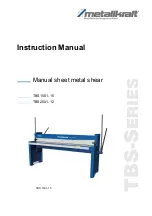
Assembly and adjustments
TBS-Series | Version 1.03
9
Fig. 6: Adjust cutting gap, nuts for position of the upper knife on the
front
Fig. 7: Adjust cutting gap, screws for position of the upper knife on the
back
Step 4: Tighten the nuts (32) on the back. Then tighten
the nuts (32) and the screws (33) on the front.
Step 5: Perform a test cut to see if the kerf is well set for
high quality cuts.
Step 6: Screw on the tool trays and the covers of the
knife guides.
Lower stop for upper knife
Step 1: Use the hand lever to lower the upper knife until
the left end of the upper knife overlaps the lo
-
wer knife by approx. 2-3 mm.
Step 2: Loosen the nuts (81) and bring the stop into con
-
tact with the cam (36). Then tighten the nuts
(81).
Fig. 8: Lower stop for upper knife
Adjust the hold down
In order to ensure a uniform fixation of the workpiece du
-
ring cutting, the hold-down can be adjusted.
Step 1: Loosen the nuts (9) on the underside of the ma
-
chine and adjust the position of the blank hol
-
der with the adjusting screws (8). Then tighten
the nuts (9).
Step 2: Check whether there is a uniform fixation of the
workpiece. If necessary, readjust the position
of the hold-down.
Fig. 9: Workpiece hold-down (left), adjusting screw (right)
Behind-stop
In order to be able to process several workpieces with
the same dimensions, the stop on the back of the device
can be set to the desired dimension.
Fig. 10: Adjust rear stop: Clamping screw, handwheel and scale
Step 1: Loosen the clamping screws on both sides of the
stopper.
Step 2: Move the stop to the desired position with the
handwheel. The position value can be read on
the scale.
Step 3: Tighten the clamping screws on both sides of the
stopper.
















